Away with Aphelion, a Comet for Binos, the Evening Moon Earns Looks, and Planets Aplenty!
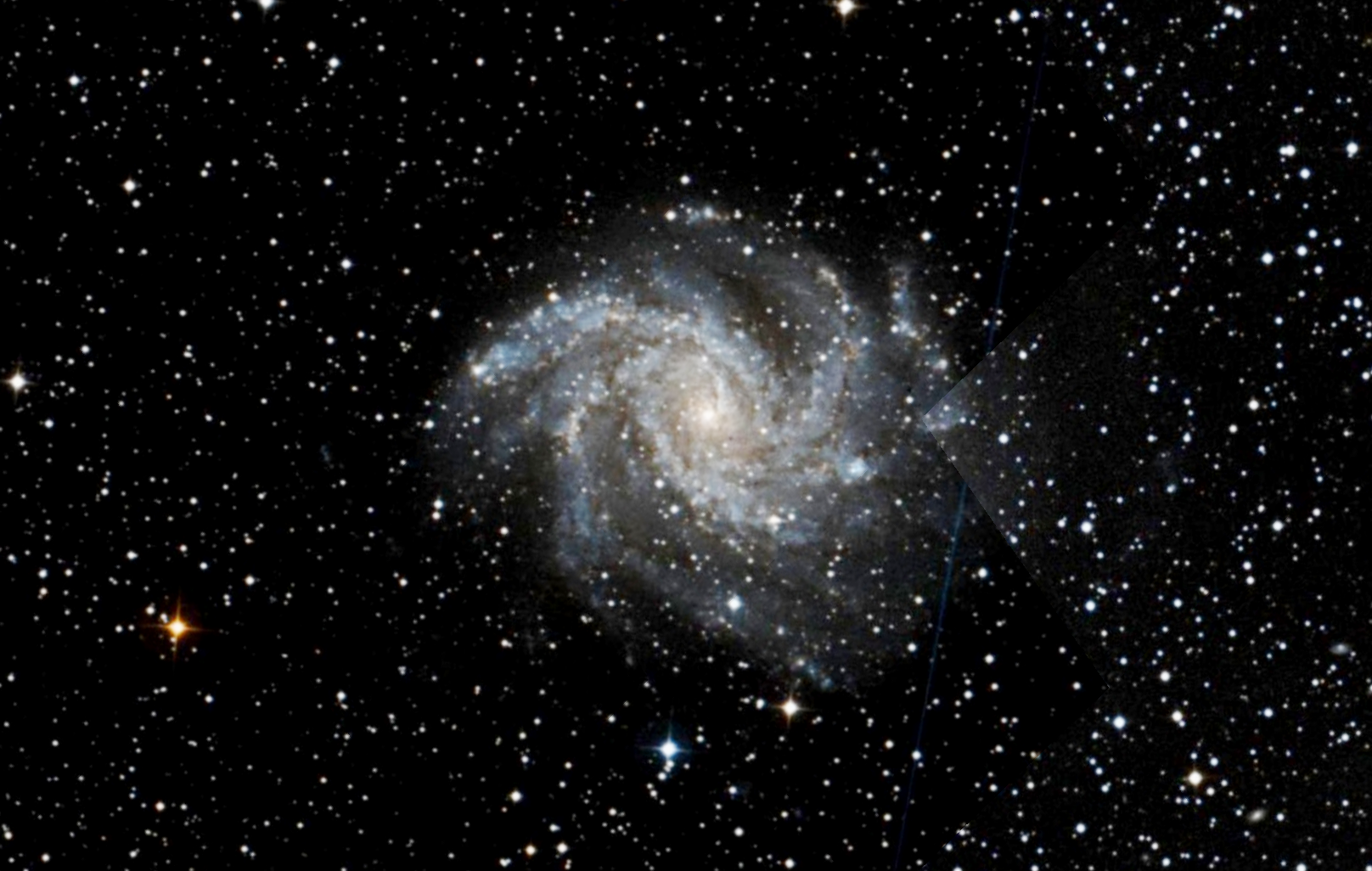
In celebration of July 1 in Canada and July 4 in the USA, here is a photo of the Firecracker Galaxy, also known as NGC 6946 and Caldwell 12. The magnitude 9.6 face-on, type SAB spiral galaxy, 25 million light-years distant, is visible in good binoculars and backyard telescopes under dark skies. It straddles the border between Cepheus and Cygnus, and sits about halfway up the northeastern sky at 11 pm local time at mid-northern latitudes. This north-up image spans 25 arc-seconds left-to-right, almost the diameter of the full moon.
Hello, July Stargazers!
Here are your Astronomy Skylights for the week of July 3rd, 2022 by Chris Vaughan. Feel free to pass this along to your friends and send me your comments, questions, and suggested topics. I repost these emails with photos at http://astrogeo.ca/skylights/ where the old editions are archived. You can also follow me on Twitter as @astrogeoguy! Unless otherwise noted, all times are expressed in Eastern Time. To subscribe to these emails please click this MailChimp link.
If you’d like me to bring my Digital Starlab portable inflatable planetarium to your school or other daytime or evening event, or deliver a session online, contact me through AstroGeo.ca, and we’ll tour the Universe, or the Earth’s interior, together! My terrific new book with John A. Read entitled 110 Things to See With a Telescope is a guide to viewing the deep sky objects in the Messier List – for both beginners and seasoned astronomers. DM me to order a signed copy!
Earth will be farthest from the sun on Monday. The moon will beckon our attention worldwide as it waxes fuller during evening this week. Before it brightens too much, try to see Comet K2 in Ophiuchus. And planet-watchers can catch Saturn before midnight or collect the entire set before dawn. Read on for your Skylights!
Earth at Aphelion
On Monday, July 4 at 3 am EDT, or 07:00 Greenwich Mean Time, Earth will reach aphelion, its maximum distance from the sun for this year. The aphelion distance of 152.1 million km is 1.67% farther from the sun than the mean Earth-sun separation of 149.6 million km, which is also defined to be 1 Astronomical Unit or 1 A.U. Earth’s minimum distance from the sun, or perihelion, will occur on January 4, 2023. At that time, the Earth will be 147.1 million km from the sun. In a telescope equipped with a proper solar filter, the July 4 sun will appear a little smaller than it was in January.

Our seasonal temperatures are not controlled by our distance from the sun. It’s the duration and intensity of sunshine we receive that makes the most difference – and that is controlled by how much Earth’s axis tilts toward (or away from) the sun.
The Moon
This will be a terrific week to take in the sights of the moon – with unaided eyes, binoculars and through any size of telescope. Our natural satellite will rise during the daylight hours and then shine in the west during evening. It’s fun to find the moon in daytime, and perfectly safe to look at the moon with optical aids in daytime – as long as you don’t let anyone (i.e., junior astronomers) aim them near the sun.
Everyone on Earth sees the moon showing the same illuminated phase; but observers in the Southern Hemisphere see the moon upside-down compared to northerly observers! The familiar patterns formed by the moon’s bright and dark patches (I always see Wilma Flintstone’s head) are inverted, suggesting new stories. Moreover, when Southern Hemisphere observers visit the north, and vice versa, east and west are swapped – so the sun, moon, planets, and stars cross the sky in the opposite direction. That takes some getting used to when you travel the world and look up!
As the moon increases its angle from the sun each day, it will wax in phase, set about 25 minutes later, and migrate east across the stars. Use your binoculars or telescope to view the terrain along the pole-to-pole lunar terminator that divides its dark and lit hemispheres. The terminator is the zone where the sun is rising on the moon. Sunlight arriving there will be nearly horizontal, producing severe shadows to the lunar west of every bump, ridge, mountain, and crater rim. With no atmosphere on the moon to scatter light, the edges of those shadows are sharp, producing spectacular vistas in binoculars and any size of telescope.
In as little as a few hours you can note differences in the way features are lit and shadowed. Watch craters fill with light, led off by their central peaks. During a romantic date on Earth, you can pause your dinner to watch the sun set. It only takes a few minutes. On the moon, the restaurants have no atmosphere, and the sun takes hours to rise or set. No atmosphere means you’ll see no red sunset glow either!
Tonight (Sunday) the waxing crescent moon will shine prettily to the left (celestial southeast) of the Sickle asterism in Leo (the Lion). The Sickle appears as a backwards question mark formed by six stars, anchored at the bottom by very bright Regulus. It is 1.5 fist diameters in height and represents the chest and head of the lion. On July evenings, it is tilted to the west as the lion settles for the night. On Monday night the moon’s eastward orbital motion around Earth will shift it to shine under the lion’s hindquarters, formed by a triangle of three medium-bright stars named Denebola, Zosma, and Chertan.
Due to the moon’s 1.5° axial tilt and its orbital inclination (or tilt) and ellipticity (or out-of-roundness), the moon nods up-and-down by up to 7° and twists left-to-right up by to 8° while keeping the same hemisphere pointed towards Earth. Over time, this lunar libration effect lets us see an extra 9% of the moon’s total surface without having to leave the Earth! Lunar features that are normally smeared along the moon’s edge or completely hidden can rotate into clearer view for a few nights. The librated sector of the moon’s limb migrates clockwise around the moon over a lunar month – but librated features can only be observed if their sector happens to be illuminated at the same time.
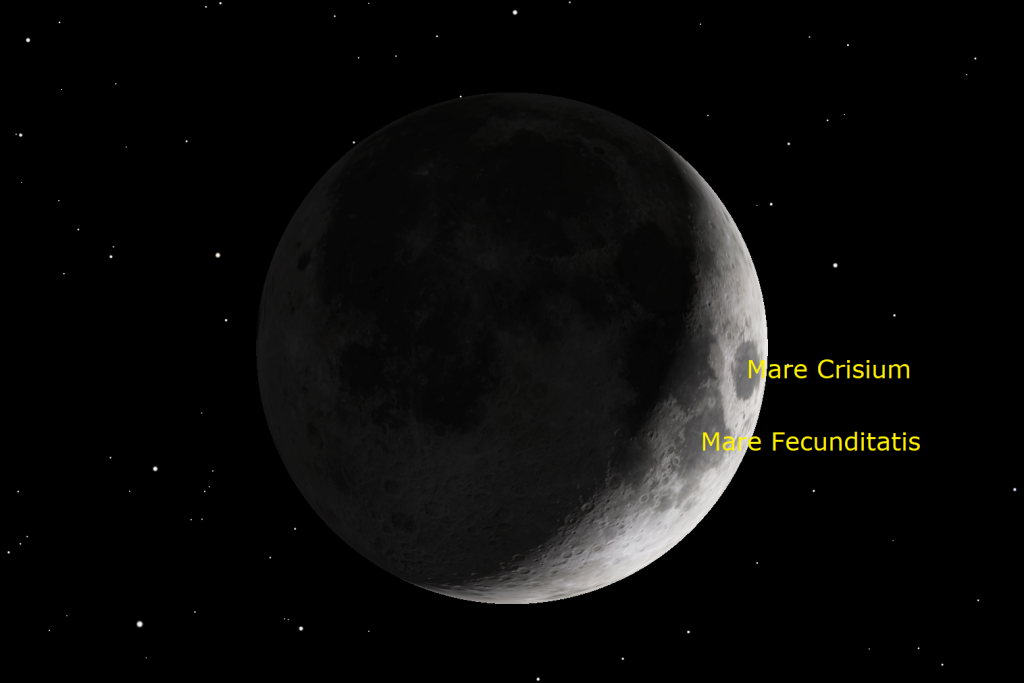
For the first few nights of this week, you can see libration’s effect on the moon at a glance by watching Mare Crisium “the Sea of Crises”. That’s the isolated, dark, round feature located near the right-hand (eastern) edge of the moon, just north of the moon’s equator. Mare Crisium becomes fully illuminated starting about four days after new moon each month. Whenever the waxing crescent moon is descending in the western sky after sunset, Mare Crisium is the most noticeable dark blob within the illuminated crescent. Because the moon’s southwestern edge will be rotated toward Earth during the next few days, Mare Crisium will sit extra close to the moon’s opposite edge.
From Tuesday to Thursday the moon will traverse the lengthy constellation of Virgo (the Maiden). It will complete the first quarter of its orbit around Earth, as measured from the previous new moon, on Wednesday, July 6 at 10:14 pm EDT or 7:14 pm PDT. (That converts to 02:14 GMT on July 7.) The 90-degree angle formed by the Earth, sun, and moon at that time will cause us to see our natural satellite half-illuminated – on its eastern side. The way the terminator straightened at the quarter moons, and curved during the rest of the lunar month, let ancient astronomers deduce that the moon was a sphere.
On Friday night, the now waxing gibbous moon will shine just to the right of the medium-bright double star Zubenelgenubi in Libra (the Scales). Wednesday to Friday will be an excellent time to view the three impressive, curved mountain chains that encircle the eastern rim of dark Mare Imbrium. That giant impact basin, covering much of the north-central portion of the moon’s Earth-facing hemisphere, will be partly in light and partly in shadow. Those mountains, actually segments of the old crater rim, will be starkly illuminated by slanted sunlight.
The most northerly arc of mountains is the Lunar Alps, or Montes Alpes. Their peaks reach up to 2400 metres above the moon’s average surface. Use binoculars or a telescope to look for a gash cutting through them called the Alpine Valley, or Vallis Alpes. It’s a rift valley, up to 10 km wide, where the moon’s crust has dropped due to faulting. To the lower right (lunar southeast) of the Alps are the Caucasus Mountains, or Montes Caucasus. This stubby, but high (up to 6000 metres tall) mountain range disappears under a lava-flooded zone connecting Mare Imbrium with Mare Serenitatis. The mountains resume along the southeastern edge of Mare Imbrium as the lengthy Apennine Mountains, or Montes Apenninus. They, too, peter out near the prominent crater Eratosthenes, and the larger crater Copernicus beyond it. The Apennines have several large peaks reaching 5000 metres high.
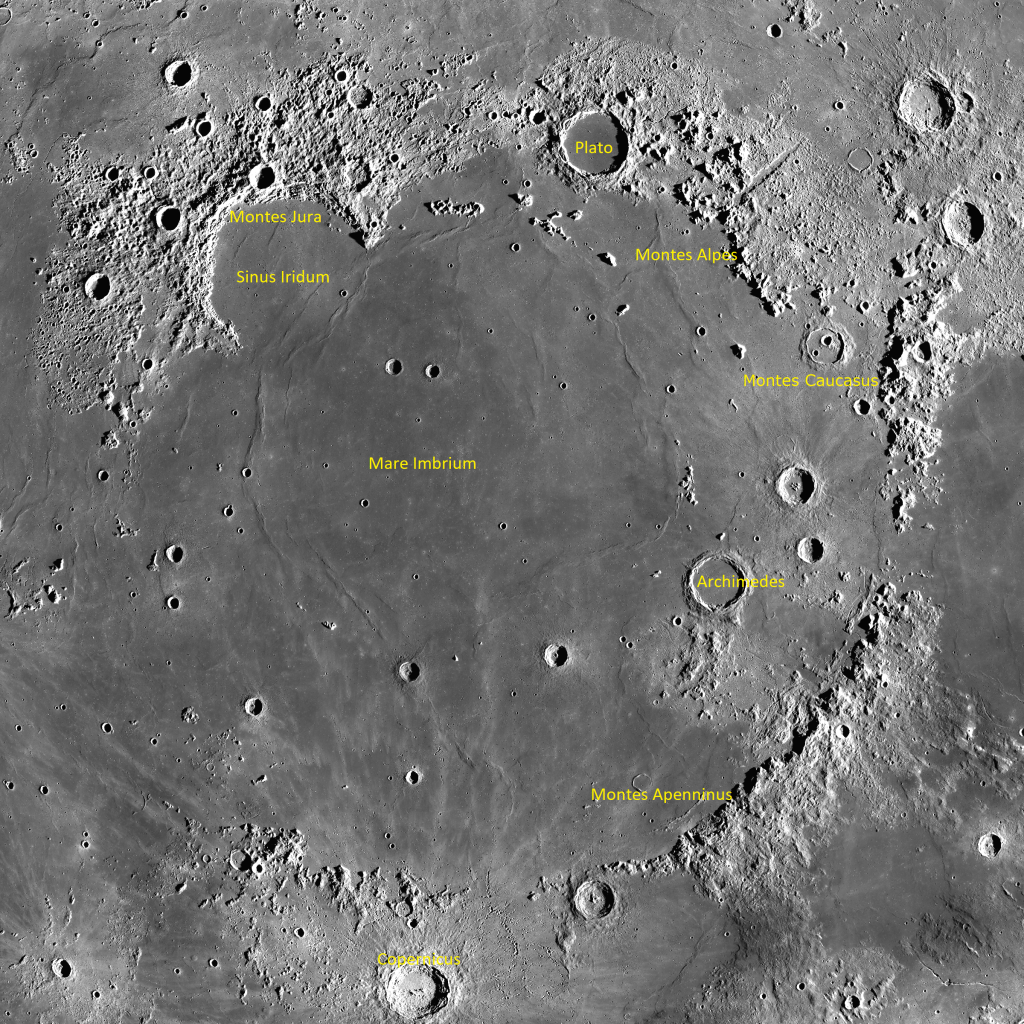
On Thursday, the terminator will fall just to the left (or lunar west) of Rupes Recta, also known as the Lunar Straight Wall. The rupes, Latin for “cliff”, is a north-south aligned fault scarp that extends for 110 km across the southeastern part of Mare Nubium. That’s the dark patch sitting in the lower third of the moon’s Earth-facing hemisphere. The wall, which is very easy to see in good binoculars and backyard telescopes, is located above the very bright crater Tycho.
On Saturday night the bright moon will shine in eastern Libra (the Scales), just to the right of the up-down line of stars that form the claws of Scorpius. Libra’s stars used to mark the tips of that beast’s much larger claws. In Arabic, zubānā means “scorpion’s claws”. The Libra star names Zubenelgenubi “southern claw”, Zubeneschamali “northern claw”, and Zubenelhakrabi “claws of the scorpion” still recall that former use.

On Saturday, the terminator will fall just west of Sinus Iridum “the Bay of Rainbows”. That semi-circular, 249 km diameter feature is a large impact crater that was later flooded by the same basalts that filled the much larger Mare Imbrium to its east – forming a rounded “handle” on the western edge of the mare. The “Golden Handle” effect is produced when low-angled sunlight strikes the prominent Montes Jura mountain range surrounding Sinus Iridum on the north and west – the former crater rim. Sinus Iridum is almost craterless, but hosts a set of northeast-oriented wrinkle ridges that are revealed at this phase.
The moon will end the week shining to the left (or celestial east) of Scorpius’ remaining claw stars Acrab, Dschubba, and Fang next Sunday night. The very bright, reddish star Antares will twinkle two finger widths to the moon’s lower right (or 2° to the celestial south-southwest). They’ll be close enough to share the view in binoculars and backyard telescopes at low magnification. Antares marks the heart of Scorpius. Its name is Latin for “rival of Mars”, referring to its visual resemblance to that planet.
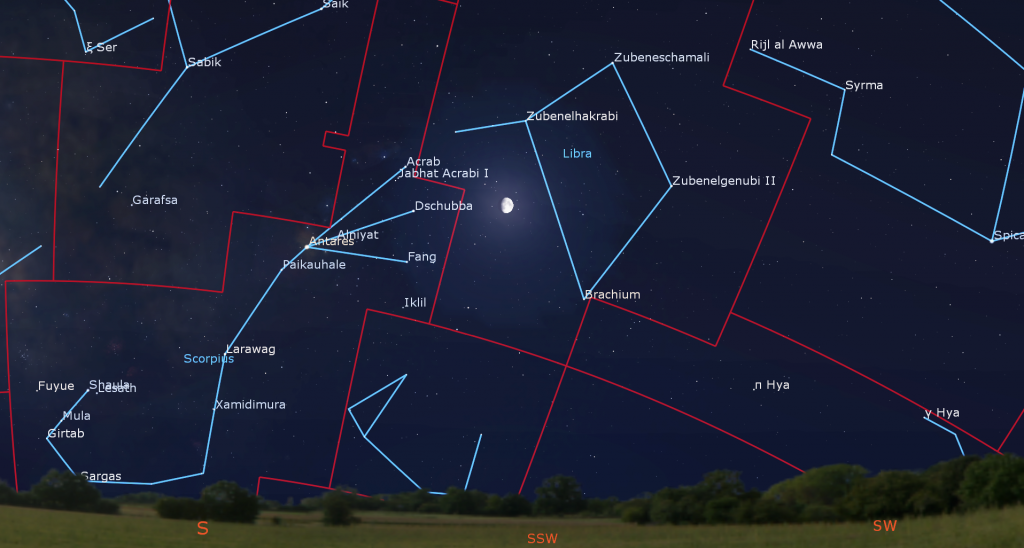
The Planets
Technically, the lengthy chain of five bright planets, arranged in order of their distance from the sun, is still visible just before sunrise as this week begins. But Mercury’s descent into the dawn twilight will hide it in a day or two – unless you are viewing it from the tropics.
Never fear, the remaining planets Venus, Mars, Jupiter, and Saturn offer plenty to enjoy. As a bonus, the faint outer ice giant planets Uranus and Neptune, plus the dwarf planet Pluto are there, too – if you know where to look.
There’s no need to set the alarm to see a planet nowadays. The pale yellow dot of Saturn will rise above the east-southeastern horizon at around 10:45 pm local time tonight (Sunday), and then four minutes earlier on each subsequent night. Before long, you’ll discern the modest stars of eastern Capricornus (the Sea-Goat) around the ringed planet. By sunrise, Saturn will be fading from view in the lower part of the southern sky. Any size of telescope will show you Saturn’s globe both above and below its tilted rings, and up to a handful of its moons arrayed all around the planet. Since Saturn is now moving slowly westward in a retrograde loop that will last until late October, you can watch it shift to the right above Capricornus’ easterly tail star Deneb Algedi over the coming weeks.
By 1 am local time, the very bright, white dot of Jupiter will appear above the eastern rooftops – positioned 4.3 fist diameters to the lower left (celestial northeast) of Saturn. Jupiter will climb to halfway up the southeastern sky by sunrise. In binoculars, the planet’s large globe, 11 times wider than Earth’s, will be flanked by its row of four Galilean moons. In a telescope, the planet will sport dark bands running parallel to its equator, and the Great Red Spot on Monday, Wednesday, and Friday morning. The large, black shadow of Ganymede will cross Jupiter on Monday morning, and the small shadow of Io will cross Jupiter on Friday morning. Jupiter will spend the next two months gliding through the northwestern corner of Cetus (the Whale).
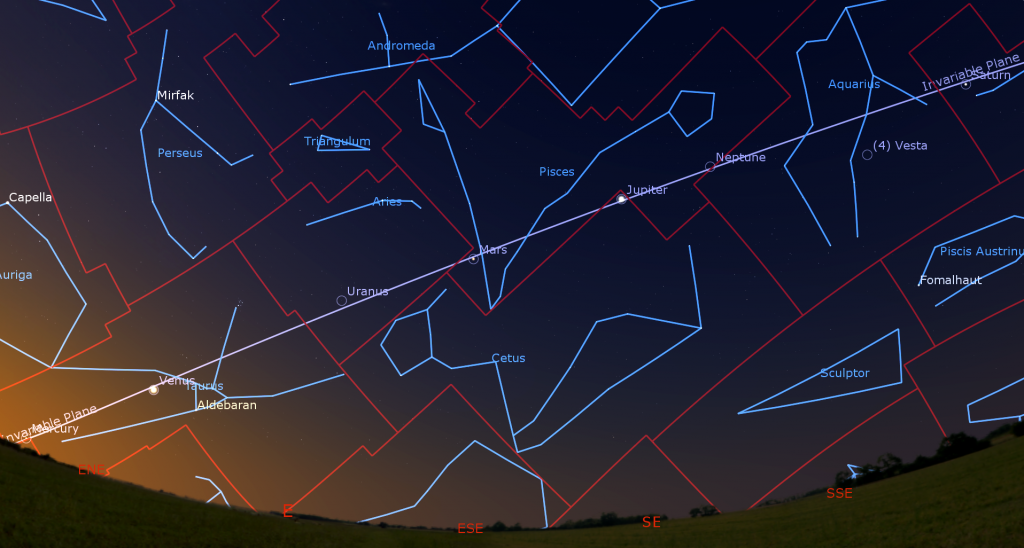
Reddish Mars will appear low in the eastern sky after 1 am local time, shining about two fist diameters to the lower left of Jupiter. Mars’ distance from Jupiter will increase a little bit every morning. In a telescope, Mars will show a tiny, 85%-illuminated disk. The red planet will brighten very slowly and grow larger as Earth’s faster orbit draws us closer to it over the coming months.
For observers in mid-Northern latitudes, extremely bright Venus will rise over the east-northeastern horizon around 3:30 am local time every morning. Venus will exhibit a waxing, nearly-round shape when viewed in a telescope or in good binoculars. Mercury will show up above the east-northeastern horizon at about 4:30 am local time – completing the chain of planets – but it will slide “leftward” toward the sun each morning. Turn all optics away from the eastern horizon before sunrise, please!
The Saturn-Jupiter-Mars-Venus line is tracing the plane of the solar system across the sky. The main belt asteroid designated (4) Vesta will be positioned a generous fist’s diameter to Saturn’s lower left (or 13° to the celestial east). Vesta is slowing its roll through central Aquarius (the Water-Bearer) as it prepares to enter a period of retrograde motion next week. To see its magnitude 6.5 speck you’ll need to hunt for it with good binoculars or a backyard telescope between about 1 and 4 am local time (i.e., before the sky brightens). During the same interval, you can use a telescope to seek out the blue speck of magnitude 7.9 Neptune, which will be positioned a finger’s width to the right of a star named 20 Piscium. That star is a fist’s diameter to the right of Jupiter, and on the line joining Jupiter to Saturn.
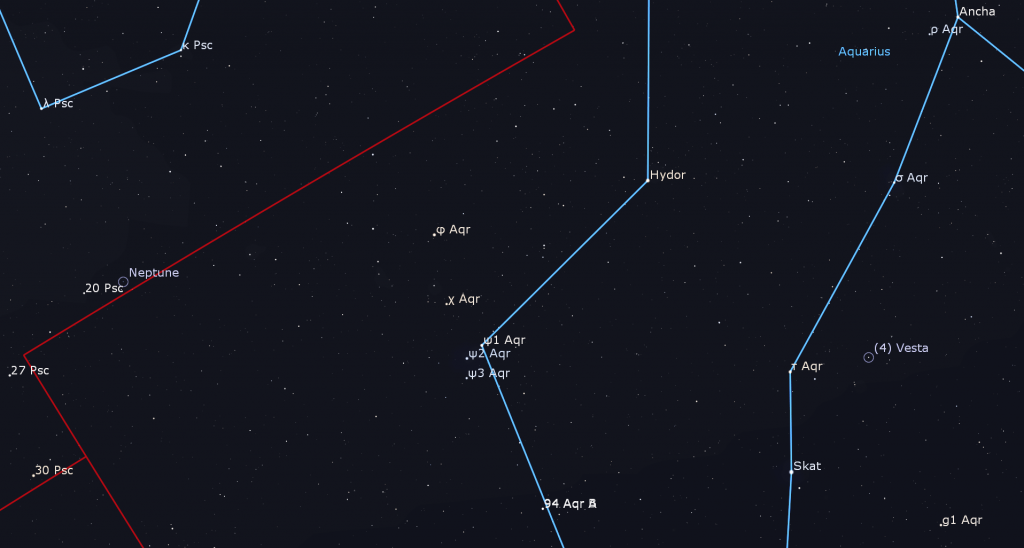
The blue-green dot of Uranus will be sitting about midway between Venus and Mars. Its magnitude of 5.8 will allow you see it in binoculars and any size of telescope between 3 and 4 am local time. The brightest star near Uranus is the medium-bright star named Botein (or Delta Arietis). Uranus is several finger widths to its right (or 4° to the celestial southwest).
Faint Comet Update
A comet named C/2017 K2 (PanSTARRS) is currently observable worldwide in good binoculars and backyard telescopes, especially if you view it from an area unaffected by artificial light. In smaller telescopes, comets resemble fuzzy grey stars. In larger telescopes, you might see a hint of green colour and a faint tail pointed away from the sun.
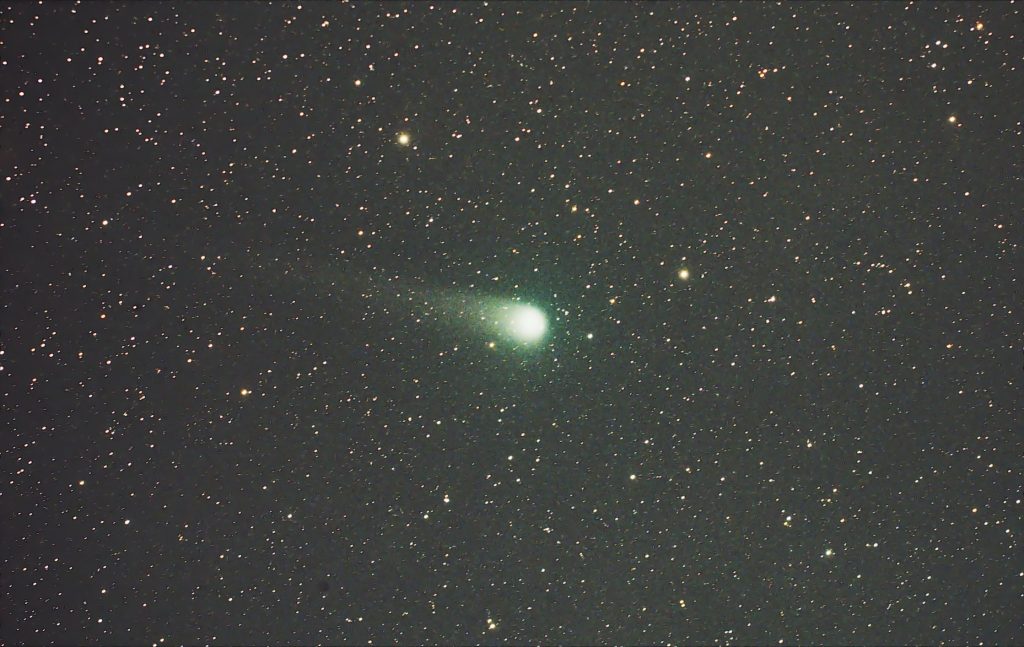
Comet K2 is still near its peak brightness of about magnitude 8.5. This week, it will be travelling downwards to the right (or celestial southwestward) through central Ophiuchus (the Serpent-Bearer). Ophiuchus’ Dalek-shaped, boxy form sits about halfway up the southern sky in late evening. Tonight (Sunday), the comet will be located a palm’s width to the lower right (or 7° to the celestial southwest) of the bright star Cebalrai. The comet will be visible all night long, but it will be most easily seen while it is highest in the sky at midnight. On the coming weekend the comet will have shifted to sit in the centre of the box, about midway between the medium-bright double star named 41 Ophiuchi and 30 Ophiuchi.
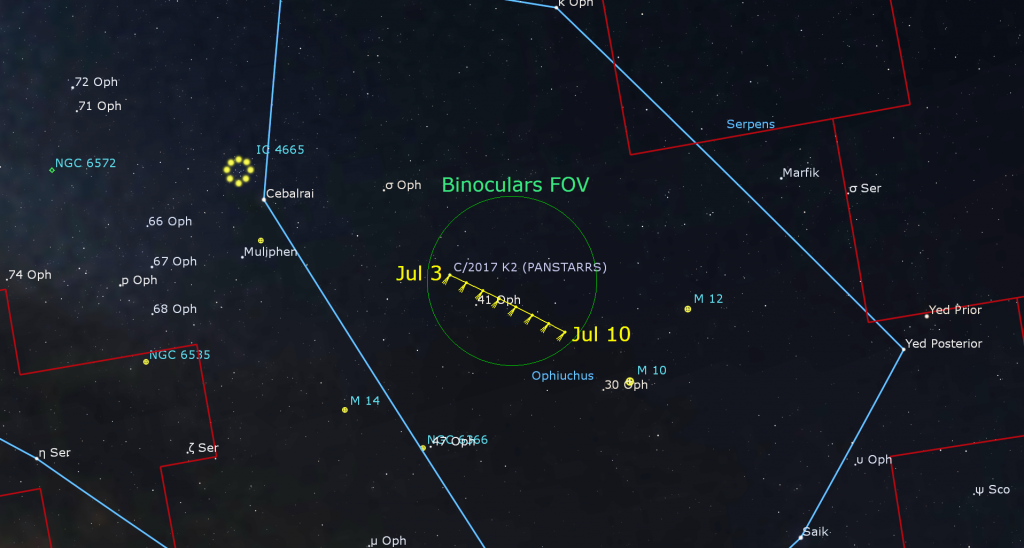
Ogling Ophiuchus
Last week, I wrote about the lesser-known summertime constellation of Ophiuchus (the Serpent-Bearer), and the zodiac. I posted it here.
Public Astro-Themed Events
Every Monday evening, York University’s Allan I. Carswell Observatory runs an online star party – broadcasting views from four telescopes/cameras, answering viewer questions, and taking requests! Details are here. They host in-person viewing on the first clear Wednesday night each month. Other Wednesdays they stream views online via the observatory YouTube channel. Details are here.
Taking advantage of the crescent moon in the sky this week, the RASC Toronto Centre astronomers will hold their free monthly public City Sky Star Party in Bayview Village Park (steps from the Bayview subway station), starting between 8:30 to 9 pm on the first clear weeknight this week (Mon, Wed or Thu only). You don’t need to be an RASC member, or own any equipment, to join them – looks are free! Check here for details, and check the banner on their website home page or Facebook page for the GO or NO-GO decision around 5 pm each day.
My free, family-friendly Insider’s Guide to the Galaxy webcasts with Samantha Jewett of RASC National returns on Tuesday, July 5 at 3:30 pm EDT, when we’ll celebrate Canadians in the Stars and a summer planet preview! Plus, we’ll continue with our Messier Objects observing certificate program and share some galaxy-viewing tips. You can find more details and the schedule of future sessions here.
On Tuesday, July 5 from 7 to 8 pm EDT, the Dunlap Institute at University of Toronto will stream their popular Astro Trivia Night. The live, free event will feature lots of fun and prizes. Details are here.
Weather permitting, on Tuesday, July 5 from 9 to 10:30 pm, astronomers from RASC – Mississauga will hold a public star party at the Riverwood Conservancy, 4300 Riverwood Park Lane, Mississauga. Details and the ticket registration link are here.
On Wednesday evening, July 6 at 7:30 pm EDT, the RASC Toronto Centre will live stream their monthly Recreational Astronomy Night Meeting at https://www.youtube.com/rasctoronto/live. Talks include The Sky This Month, and a talk about making your own telescope. Details are here.
On Thursday, July 7 at 8:30 pm EST, the Department of Astronomy & Astrophysics at the University of Toronto will stream their AstroTour. The live, free event will feature PhD Candidate Martine Lokken discussing Filamentary, My Dear Watson: How the cosmic web can help us solve the universe’s mysteries. Details and the YouTube link are here.
Eastern GTA sky watchers are invited to join the RASC Toronto Centre and Durham Skies for solar observing and stargazing at the edge of Lake Ontario in Millennium Square in Pickering on Friday evening, July 8, from 7 pm to midnight. Details are here. Before heading out, check the RASCTC home page for a Go/No-Go call – in case it’s too cloudy to observe.
RASC’s Public sessions at the David Dunlap Observatory may not be running at the moment, but they are pleased to offer some virtual experiences instead in partnership with Richmond Hill. The modest fee supports RASC’s education and public outreach efforts at DDO. Only one registration per household is required. Prior to the start of the program, registrants will be emailed the virtual program link.
On Sunday afternoon, July 10 from 11 am to noon EDT, join me for DDO Ask an Astronomer. During the family-friendly session, I’ll answer your questions about the universe and review what’s up nowadays. The deadline to register for this program is Wednesday, July 6, 2022 at 3 pm. More information is here and the registration link is here.
Don’t forget to take advantage of the astronomy-themed YouTube videos posted by RASC Toronto Centre and RASC Canada.
Keep looking up, and enjoy the sky when you do. I love questions and requests. Send me some!